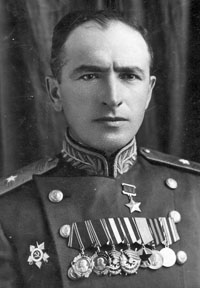
Simon Kremer
This man had two military biographies rather than only one.
In a questionnaire that Simon Kremer, then a colonel, filled in the end of the Soviet-German War, this future major-general of the tank forces wrote in the item "Education": "Three years of study in a talmud-torah (a Jewish school for the poor) in Gomel; studied in the military department of Sverdlov University in Moscow; graduated from the Frunze Military Academy in Moscow." This list was far from complete, but it is interesting to note that Kremer found it important to mention his Jewish traditional Jewish schooling (which he did not finish) as the starting point of his education.
Shimon Kremer was born in Gomel, southeastern Belorussia in 1900. When the boy was five years old, his father David, an artisan, died. Despite the economic hardship, in 1907 his mother was able to send him to an elementary religious school mainly for poor children in 1907. In 1911, however, Shimon left the talmud-torah and was taken on as an apprentice in a tailor's shop, where he learned the trade and then worked at it for the following six years.
With the start of the Bolshevik revolution in November 1917, Shimon Kremer joined the Communist Red Guard and was wounded during the fighting in Belorussia. In February 1918, while he was in a hospital in Gomel, the Red Army was formed, and in November Kremer volunteered to join it. He took part in the suppression of the anti-Communist Strekopytov rebellion in March 1919 and in the Soviet-Polish War of 1919-21, first as a private, then as a platoon commander. In 1921, he was appointed military commandant of Novo-Belitsa (now part of Gomel) and deputy head of the Soviet police there.
In 1922, Kremer graduated as a political worker from the military department of Sverdlov Communist University in Moscow and from 1922 to 1925 served as political commissar of a regiment. Between 1926 and 1931, he was commander of a cavalry unit. In 1934 Kremer graduated from the Frunze Military Academy and moved from the cavalry to the tank forces. From then for two years he was deputy head of the operative department of a tank corps.
In July 1943, during the third year of the Soviet-German war, Colonel Kremer was sent to the front as a tank brigade commander of the 7th Guards Tank Corps, that was deployed on the central part of the Soviet-German front. At first, corps commander Ivan Korchagin refused to trust the command of a brigade to a man who had not been in active service in the tank forces for seven years and appointed Kremer deputy commander of the 24th brigade of his corps. However, after the Chernigov-Pripiat operation in September 1943, Korchagin appointed Kremer (who at this time was in a military hospital after being seriously wounded) his deputy in the corps.
Kremer requested to be released from the hospital after he heard over the radio that his hometown Gomel had been liberated. In December 1943, he returned to the frontlines as the commander of the 8th Tank Brigade. This brigade fought in Belorussia, Lithuania, and Latvia in 1944. An interesting episode involved Simon Kremer at this time. On July 30, 1944 the 8th Tank Brigade entered the Latvian town of Tukums. On the next day, one of brigade's units reached the Gulf of Riga. On July 31, Kremer reported by radio to the HQ of the corps "We are at the beach of the Gulf of Riga." The commander of the corps refused to believe him and issued to following order: "Fill three bottles with water from the sea. Seal the bottles and have the commander personally sign on each of them that the water had in fact been taken from the Baltic Sea. The water bottles are to be sent to the corps headquarters." Kremer carried out this order. Within several days, the three signed bottles were standing on a table during a meeting of the Stavka (the HQ of the Red Army). Kremer was awarded the title of Hero of the Soviet Union and promoted to the rank of major-general.
In September 1944, in Latvia. General Kremer was seriously wounded again.
The war did not end for Simon Kremer in May 1945. In June of that year he was transferred to the Far East, where he took part in battles in northeast China. After the war, he continued his service in the Soviet Army. Kremer retired in 1956. He died in Odessa in 1991.
Shortly after Kremer's death, his name began to appear in the pages of newspapers and books. At that time, this was not in connection with the Soviet-German war but with quite another field of endeavor.
In 1936, tank officer Simon Kremer was unexpectedly transferred to the Main Intelligence Directorate of the Red Army. From 1937 to 1942 he served as secretary of the military attaché of the Soviet embassy in Britain. In this capacity, in 1941 he established contact with the British nuclear physicist Klaus Fuchs, who participated in the development of the British atomic bomb in the framework of the Tube Alloys project. Several other agents beside Fuchs were also recruited by Kremer and provided him with the information about the project. In the 1990s, Simon Kremer was hailed as one of the most prominent Soviet spies and as the "god-father" of the Soviet nuclear bomb. In 1942, he returned to the Soviet Union and for a year headed the Faculty of Western Languages at the Military Institute of Foreign Languages in Moscow. In 1943, Kremer asked to be returned to the active service – and resumed his career of tank officer.
